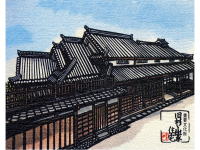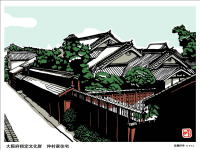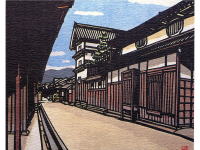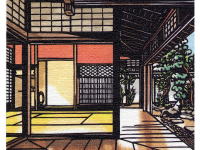富田林寺内町の探訪
I'm glad to intorduce an old town, Jinaimachi, Tondabayashi, Osaka, Japan as a national historic district and heritage site.
It takes 30 minutes from Osaka city to Tondabayashi station by Kintetsu railways. A 10-minutes walk will take you to the historic town.
ギャラリー
History of jinaimachi town, tondabayashi, a historic district, japan
| 【Tourist guide to Jinaimachi town, Tondabayashi, a historic district and heritage site of Japan, History Page 1/4】 | |
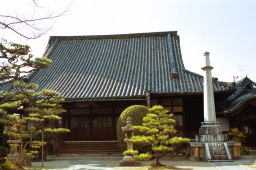 Koushouji Betsuin Temple main hall and Memorial Monument of Founder, Shoshuu Shonin |
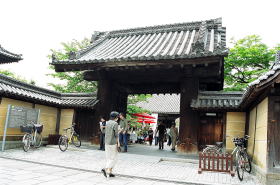 Koushouji Betsuin Temple・Main Gate |
| Jinaimachi town in Tondabayashi prospered under the peace strategy with
Nobunaga Oda During the Warring States period (1467-1562), autonomous mission towns called Jinaimachi were born in Japan. This urban village that had been formed in contact with the precincts of the temple, began to establish autonomy in discharging the interference of lords. There still remain Jinaimachi townscapes such as Imai town in Kashihara city, Nara Prefecture and Sakai in Osaka prefecture, and Tondabayashi here is one of such. Among those, the most famous Jinaimachi town was Osaka Jinaimachi town built around the Ishiyama Honganji Temple. Ishiyama Honganji town was defeated by Nobunaga Oda after a decade of battle from 1570 and was thoroughly destroyed. It is not possible to see its remnants at all now. On the other hand, Settsu Kawachi and Tondabayashi chose peace and showed the reverence for the powerful warlord, Nobunaga Oda. Jinaimachi towns remaining in the various places are those which had survived by seeking reconciliation policy in the conflict relationship with Nobunaga Oda who aimed at suppression of Ikkouikki battles led by Jodo Shinshuu sect. and those successfully won the prosperity of the towns then and thereafter However, the background Tondabayashi enjoyed the prosperity like today was, needless to say, that there was a military force of Jodo Shinshuu believers which often formed Ikkouikki battles. (Excerpt from the book titled of "house " written by Mr. Kiyoshi Takai published by Tankousha, December, 2002) |
|
| Penetration of Ikkoushuu sect. (Jodo Shinshu sect.) into people during
Muromachi period As it dates back to late 15th century in the Muromachi Shogunate period, Renkyou, a Buddhist priest and the head of Koushouji Temple of Jodo Shinshuu Sect. in Kyoto opened a mission called a Nebutsu Dojo in Ebitani village in Minami-Kawachi region while he eagerly spread the missionary to the people to help Rennyo, a Buddhist priest and the head of Honganji Temple of Jodo Shinshuu Sect. in Kyoto. The old place name called Ko-Gobo, which literally means an old Buddhist temple, had been called and left in Ebitani village through the Taisho period (1912-1926). In those area extended from northern part of Ishikawa gun to Furuichi gun where Tondabayashi Betsuin Temple (Koushouji Betsuin Temple) and its affiliated 11 temples are now scattered, including Shindo, Nakano, Kishi, Kita-otomo, Yamashiro, Ichisuka, Kasuga and Yamada, a great number of believers could be successfully won. This sprout of faith among the people moved to build more missions or Nembutsu dojo one after another, which became Komyoji temple , Senkoji temple, Kyorenji temple and Enmyoji temple 50 years thereafter during Daiei period. (1521-1527) |
|
| The foundation of Koushouji Betsuin Temple (Tondabayashi Gobo) by Shoshuu
Shonin During the period of 1555 to 1558, Shoshuu Shonin, a Buddhist saint and the 16th head of Koushouji Temple in Kyoto looked for a location of mission and found a vacant field at the river terrace to the west of the banks of the Ishikawa River called Tonda-ga-shiba. Shoshuu Shonin asked the warlord, Naomasa Yasumi at the Takaya castle at the time of 1558 to trasnfer the proposed site and he purchased the property at the price equivalent to a thousand of bronze coins. Shoshuu Shonin called each two influential headmen from four neighboring villages of Nakano, Shindo, Ebitani and Yamachuda (collectively named as the eight headmen team of exploitation of Tondabashi ) , asked those believers to reclaim the wasteland, divided it into blocks, surrounded the outer edge by earthwork and bamboo forest and built up the temple in the center. This is Tondabayashi Gobo or Koushouji Betsuin Temple and the foundation of Tondabayashi Jinaimachi town in 1560. Shoshuu Shonin left the construction of Tondabayashi, planning of the town and building of the temple to the eight headmen team. The administration of the new village was carried out by the eight headmen. Two men was appointed as headmen and the remaining 6 men undertook the senior officers. The two headmen were newly appointed in turn every year among the eight men. The administration of the Gobo,or Koushouji Betsuin temple was carried out in the same manners by the headmen and senior officers, too. |
|
| Economic development as a commercial city and the protection of the lord Under the administration by the Muromachi Shogunate, the warlord Hatakeyama who was appointed as For 9 years period from 1551 through 1559, the country was governed by Naomasa Yasumi at Takaya castle and Tondabayashi Gobo was constructed in 1560 during his ruling time. Yasumi, the governor, made an order in 1561. The regulation had one article on commerce and duty. The special article was to protect various merchants who gathered in the town of Gobo. The priviledged markets dealing with various goods were called Za whcih were authorized by temples and shirines all over at that time. The article also provided commercial duty imposed on the priviledged markets were fully exempted. In other words, the residents who lived in Jinaimachi town in Tondabayashi were not supposed to be imposed. Ardent believers moved to Jinaimachi from all over. Those people who did not own their farmland and started to commerce gathered into the town, since duty was exempted other than contributions to the temple as well as town charges. In that way, Tondabayashi village as Jinaimachi town was steadily constructed while being protected. |
|
| 【Tourist guide to Jinaimachi town, Tondabayashi, a historic district and heritage site of Japan, History Page 1/4】 | |
| 【Tourist guide to Jinaimachi town, Tondabayashi, a historic district and heritage site of Japan, History Page 2/4】 | |
| 【Tourist guide to Jinaimachi town, Tondabayashi, a historic district and heritage site of Japan, History Page 3/4】 | |
| 【Tourist guide to Jinaimachi town, Tondabayashi, a historic district and heritage site of Japan, History Page 4/4】 | |
Information

Location
Jinaimachi town, Tondabayashi city, a national historic preservation district
and heritage site of Japan, which is located in the south-eastern part
of Osaka prefecture, the western part of Japan
Directions to Jinaimachi town, Tondabayashi
It is a 10-minute walk from the Tondabayashi Staion or the Tondabayashi
Nishiguchi Station of Kintetsu Nagano line.
From Kansai International Airport
Airport Limousine Bus service available bound for Kawachi Nagano Station.
(60 minutes) Please take Kintetsu railways from Kawachi Nagano to Tondabayashi.(15
minutes)
From Osaka International Airport (Itami Airport)
Airport Limousine Bus service available bound for Abenobashi Station. (30
minutes) Please take Kintetsu railways from Abenobashi terminal to Tondabayashi.(30 munites)
From JR Shinkasen Shin-Osaka station or
Osaka (Umeda) station
Please take Subway Midousuji line from Shin-Osaka station or Osaka (Umeda)
station to Tennoji Station. (20~30 minutes) Please change trains at Tennoji
and take Kintetsu railways from Abenobashi terminal to Tondabayashi. (30
minutes)
The site-seeing map available in English
Please stop by to the Tourist Information Cetnter or Jinaimachi Visitor
Center.
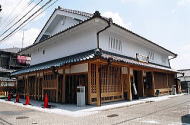
Visitor Center
(Jinaimachi Kouryuukan,
Town Community Center)
Address
9-29, Tondabayashi-cho, Tondabayashi city, Osaka, 584-0033, Japan
TEL.+81-(0)721-26-0110
FAX.+81-(0)721-26-0110
open 10a.m. until 5 p.m.
closed on Monday
Restrooms
Available at Jinaimachi Visitor Center (Jinaimachi Kouryuukan), Jinaimachi
Center and Jinaimachi Tenbou Hiroba (Viewing Terrace)
Visitor Parking
Road width is very narrow in Jinaimachi town. If traveling by car, please
use Tondabayashi Municipal east parking newly opened in February 2014 (Toll
parking).
You can park the minibus for groups and passenger cars for general use.
Only one parking lot available for minibus, you must book it in advance
with Tondabayashi City Hall. A 15-minute walk to the Jinaimachi Visitor
Center and 5 minute walk up to the former Sugiyama family house, an important
national cultural property.
You will note that the large tourist bus for groups is requested to be
parked at the Tondabayashi City Hall No. 2 parking lot alongside the old
Route 170 (It must be booked in advance to City Hall). 20-minute walk to the Jinaimachi
Visitor Center and 10 minute walk up to the former Sugiyama family house,
an important national cultural property. Thank you in advance for your
kind cooperation.
